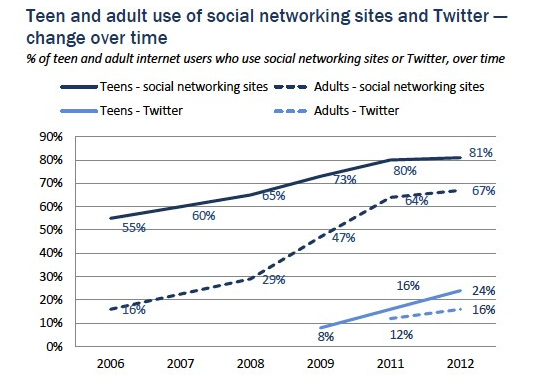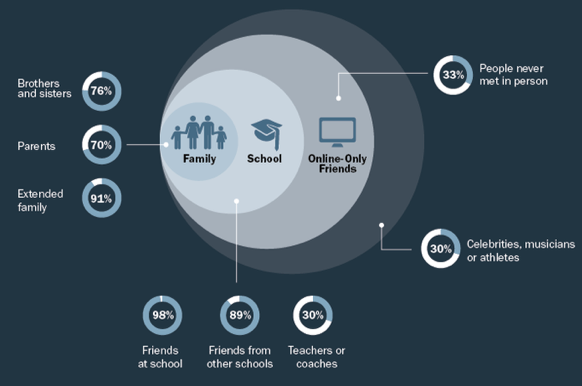By adaptive - June 4th, 2013
As one of the most active groups on social media, the teen market is increasingly becoming the focus of marketing activity.
Social media has always been associated with younger consumers. The under 25’s have become a target audience for many corporations attempting to sell their goods or services. Often however, the teenage market is overlooked, as being of little commercial value. Nothing could be further from the truth.
The spending power of the teenage market is massive. Research carried out by 02 suggests that young people spend £5 billion a year in the UK alone. What’s more, the disposable income of children is also increasing and has now reached an average of £6.84 per week in pocket money. This equates to an increase of an unbelievable 500% since 1987. And with one in ten under 15’s making an online purchase, and social media increasingly driving those decisions, your corporation must begin to pay more attention to this expanding group of lucrative customers.
Social media and the teenage population seem to go together. New research from Mintel has found that 10-15 year olds are worried that they could be shunned by their peers if they are not active enough across the most popular social media networks. What this means from a business perspective is that teenagers are being pushed towards even greater use of social media by their peer groups. The connections they make across these networks are the foundation of the recommendation economy that many businesses are trying to access.
In addition research from On Safe Internet Day and Dubit in the USA, have found that 44% of children aged between 8-12 had access to social media in the UK with only 37% of Americans, with over three-quarters stating they would like to see a ‘junior Facebook’ account for the under 13’s. And social media awareness is getting younger with the survey showing that 66% of six-year-olds have some awareness of Facebook, with just under a quarter of eight-year-olds have some access to this leading social media network.
Ian Douthwaite, CEO of Dubit, said: “This research should be welcome news to Facebook who have a great opportunity to widen their audience and legitimise these kids’ membership. It also explains the popularity of games like Moshi Monsters and Bin Weevils, which are giving children a safe place to play online. Our research shows that games are one of the main reasons for children joining social networks: This includes the fact that 36 per cent of 6-14 year-olds have played games on Facebook in the last month, higher than any other gaming portal and emphasising the importance games play in attracting children to social networks.”
Marketing messages
For marketers gaining the insight they need to craft well-targeted messages at the teenage and child market has in the past proven to be the Achilles heel when this market was considered. However, new research from Pew Internet reveals that these users are revealing more about themselves with every passing year. The key findings of the research include:
- Teens are sharing more information about themselves on social media sites than they did in the past. For the five different types of personal information that we measured in both 2006 and 2012, each is significantly more likely to be shared by teen social media users in our most recent survey.
- Teen Twitter use has grown significantly: 24% of online teens use Twitter, up from 16% in 2011.
- The typical (median) teen Facebook user has 300 friends, while the typical teen Twitter user has 79 followers.
- Focus group discussions with teens show that they have waning enthusiasm for Facebook, disliking the increasing adult presence, people sharing excessively, and stressful “drama,” but they keep using it because participation is an important part of overall teenage socializing.
- 60% of teen Facebook users keep their profiles private, and most report high levels of confidence in their ability to manage their settings.
- Teens take other steps to shape their reputation, manage their networks, and mask information they don’t want others to know; 74% of teen social media users have deleted people from their network or friends list.
- Teen social media users do not express a high level of concern about third-party access to their data; just 9% say they are “very” concerned.
- On Facebook, increasing network size goes hand in hand with network variety, information sharing, and personal information management.
In broad measures of online experience, teens are considerably more likely to report positive experiences than negative ones. For instance, 52% of online teens say they have had an experience online that made them feel good about themselves.

The level of personal detail that is offered on these profiles is astonishing and highly useful. For instance, if your business is looking at growing its localised marketing to younger age groups, 16% of teenagers that set-up a social media profile include their location. However, a quarter of this market has revealed that they often post fake or inaccurate information on their social media profiles to protect their privacy.
Older teens tend to be Facebook friends with a larger variety of people, while younger teens are less likely to friend certain groups, including those they have never met in person. Older teens are more likely than younger ones to have created broader friend networks on Facebook. Older teens (14-17) who use Facebook are more likely than younger teens (12-13) to be connected with:
- Friends who go to different schools (92% vs. 82%)
- People they have never met in person, not including celebrities (36% vs. 25%)
- Teachers or coaches (34% vs. 19%)

And it seems that the younger consumer is less concerned about how third-parties use the public personal data that their profiles contain. Overall, 40% of teen social media users say they are “very” or “somewhat” concerned that some of the information they share on social networking sites might be accessed by third parties like advertisers or businesses without their knowledge. However, few report a high level of concern; 31% say that they are “somewhat” concerned, while just 9% say that they are “very” concerned.6 Another 60% in total report that they are “not too” concerned (38%) or “not at all” concerned (22%).
And the content that is being posted to social media networks is changing and should form part of your business planning when developing new marketing campaigns.
Teen advocates
The teenage market also moves fast. There have been many headlines stating that younger users are losing interest in Facebook, even before F-commerce has found its feet in the marketplace. Facebook’s own annual report stated:
“We believe that some of our users, particularly our younger users, are aware of and actively engaging with other products and services similar to, or as a substitute for, Facebook. For example, we believe that some of our users have reduced their engagement with Facebook in favor of increased engagement with other products and services such as Instagram. In the event that our users increasingly engage with other products and services, we may experience a decline in user engagement and our business could be harmed.”
Indeed, some have pointed to Instagram as the new hangout for teens looking for the next hot social network to be a part of. And perhaps this is at the heart of the so-called waning of interest in Facebook that many reports seem to point to: Teenagers in particular don’t want to be associated with yesterday’s social network.
For businesses this means they have to move much faster than they have in the past when attempting to exploit the groups of consumers on these networks. Campaigns need to be formulated quickly and executed over short time periods to attract potential customers that may only be in that network for a short space of time. The teenage market is transient and often fickle.
And another aspect of the teenage and younger market is the influence they have on adults. Pester power has been long identified as a clear marketing tool that works. In the social media age, this has moved to a whole new level. In the US teenagers are influencing over a trillion dollars of spending.
According to Digitas: “Social media plays a key role in reaching and engaging the next generation. But a social strategy doesn’t equal social relevance—and relevance has a deadline. Brands today must be nimble and proactive, staying on top of what’s trending in the news and what their audiences are talking about, so that they can stay relevant in the eyes of their consumers. That’s the key to creating engagement.
“We believe that this generation values experiences more than products. If your brand is playing a role in that experience, making it better, then they’ll stick with it. But if not, they’ll go elsewhere. Our panel of preteens bemoaned the fact that some of their friends post constantly on social networks when they don’t actually have anything to say—they post updates just for the sake of posting. They also didn’t like being bombarded with the same brand messages over and over again; to them, a video that’s funny the first few times very quickly becomes stale and annoying. The takeaway is clear: brands need to focus on regularly providing fresh content that’s relevant to their audiences, not content just for content’s sake.”
What is clear is that corporations that count the teenage and younger consumer in their customer base need to pay close attention to how these groups are using social media networks. Their attitude to privacy and the use of personal data by third parties is interesting, but need to be carefully assessed for accuracy.
There is no doubt that younger people have massive spending power of their own, and have a huge influence on the spending habits of the adults in their lives. And as social media networks move in and out of fashion, businesses need to evolve their marketing to accommodate the ebb and flow of commerce as it moves across these networks, and how younger people are directing these changes.
Next Reads
October 2013, New York
How you can leverage social media for a more effective customer service function and better customer insight
Brochure Programme